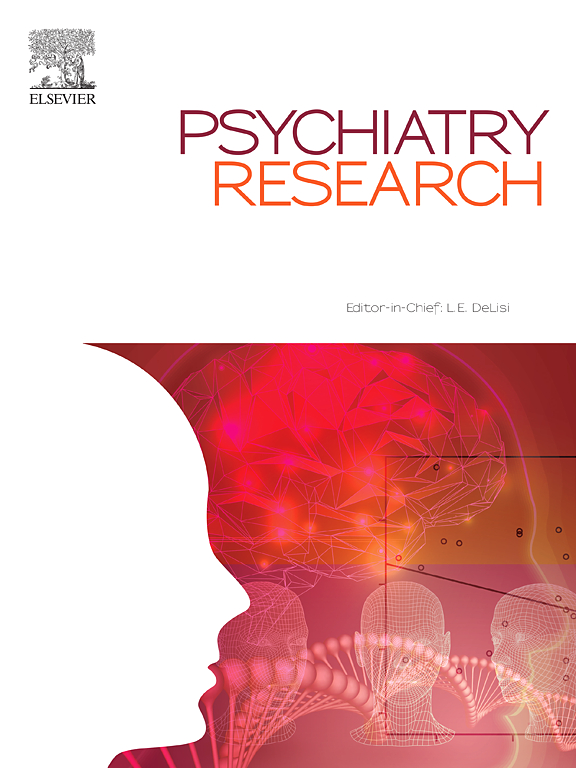Physical health correlates of co-occurring chronic pain and PTSD Among U.S. Veterans: Results from a nationally representative study
IF 4.2
2区 医学
Q1 PSYCHIATRY
引用次数: 0
Abstract
Co-occurring chronic pain and posttraumatic stress disorder (PTSD) affects between 4%-8% of the U.S. veteran population. A large body of research has documented the psychosocial burden of the co-occurrence, but fewer studies have examined physical health conditions and functioning. The current study aimed to address this gap by examining physical health conditions and functioning of co-occurring chronic pain and PTSD. Data were analyzed from the National Health and Resilience in Veterans Study, which surveyed a nationally representative sample of 4,069 (age=62.2 years) U.S. veterans in 2019–2020. The sample was predominantly male (N = 3,564; 90.2%) and non-Hispanic White (N = 3,318; 78.0%). PTSD diagnoses were determined using the PTSD Checklist for DSM-5 and chronic pain and other physical health conditions using self-report and validated measures. Logistic regression analyses revealed that veterans with co-occurring chronic pain and PTSD were generally more likely to have a physical health condition (ORs 2.79–9.53) or a cognitive disorder (OR=16.55) relative to controls (ORs 2.79–9.53). ANCOVA analyses revealed that relative to veterans with chronic pain or PTSD only, those with both chronic pain and PTSD had worse physical functioning across several domains (ds=0.32–1.13). Results underscore the importance of approaching co-occurring chronic pain and PTSD using a whole person approach to care that targets both physical and mental health concerns.
4%-8% 的美国退伍军人同时患有慢性疼痛和创伤后应激障碍(PTSD)。大量研究记录了并发症造成的社会心理负担,但对身体健康状况和功能进行检查的研究较少。本研究旨在通过研究慢性疼痛和创伤后应激障碍并发症患者的身体健康状况和功能来填补这一空白。本研究分析了 "全国退伍军人健康和复原力研究"(National Health and Resilience in Veterans Study)的数据,该研究在 2019-2020 年调查了具有全国代表性的 4069 名美国退伍军人(年龄=62.2 岁)。样本主要为男性(样本数=3564;90.2%)和非西班牙裔白人(样本数=3318;78.0%)。创伤后应激障碍的诊断采用 DSM-5 的创伤后应激障碍清单,慢性疼痛和其他身体健康状况则采用自我报告和验证措施。逻辑回归分析显示,与对照组(ORs 2.79-9.53)相比,同时患有慢性疼痛和创伤后应激障碍的退伍军人一般更有可能患有身体健康疾病(ORs 2.79-9.53)或认知障碍(OR=16.55)。方差分析显示,与仅患有慢性疼痛或创伤后应激障碍的退伍军人相比,同时患有慢性疼痛和创伤后应激障碍的退伍军人在多个领域的身体功能较差(ds=0.32-1.13)。研究结果表明,针对同时患有慢性疼痛和创伤后应激障碍的退伍军人的身体和心理健康问题,采用全人护理的方法来治疗他们的慢性疼痛和创伤后应激障碍是非常重要的。
本文章由计算机程序翻译,如有差异,请以英文原文为准。
求助全文
约1分钟内获得全文
求助全文
来源期刊

Psychiatry Research
医学-精神病学
CiteScore
17.40
自引率
1.80%
发文量
527
审稿时长
57 days
期刊介绍:
Psychiatry Research offers swift publication of comprehensive research reports and reviews within the field of psychiatry.
The scope of the journal encompasses:
Biochemical, physiological, neuroanatomic, genetic, neurocognitive, and psychosocial determinants of psychiatric disorders.
Diagnostic assessments of psychiatric disorders.
Evaluations that pursue hypotheses about the cause or causes of psychiatric diseases.
Evaluations of pharmacologic and non-pharmacologic psychiatric treatments.
Basic neuroscience studies related to animal or neurochemical models for psychiatric disorders.
Methodological advances, such as instrumentation, clinical scales, and assays directly applicable to psychiatric research.
 求助内容:
求助内容: 应助结果提醒方式:
应助结果提醒方式:


